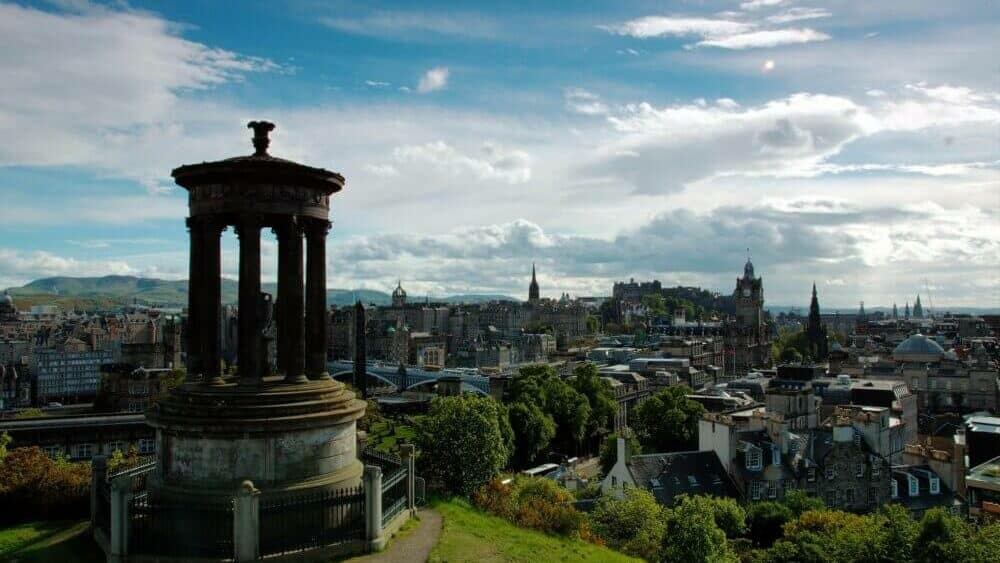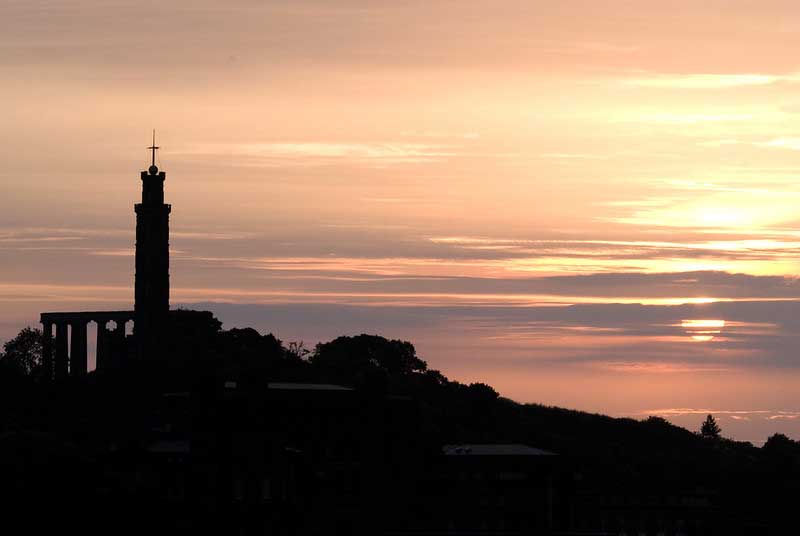Calton Hill, part of Edinburgh’s UNESCO World Heritage Site, rises at the east end of Princes Street.

This popular Edinburgh vantage point, with its unusual collection of classically styled buildings and monuments, offers visitors a panoramic view across the city and beyond.
In 1724, Edinburgh Town Council bought Calton Hill, following lobbying from philosopher David Hume.
David Hume, one of the foremost Scottish Enlightenment philosophers, doesn’t have a monument on Calton Hill. However, there is a statue of him on the Royal Mile, across the road from St Giles’ Cathedral.
Calton Hill was one of the first recreation spaces created in a very crowded city and one of the first public parks in Scotland. It was said Hume “for the health and amusement of the inhabitants.”
On a clear day, you can see Salisbury Crags, Arthur’s Seat and further on to North Berwick and the Bass Rock.
What can you see from the top of Calton Hill?
From the top, visitors can see some of Edinburgh’s best-known landmarks.
That includes Arthur’s Seat, the Scottish Parliament building, the Palace of Holyroodhouse, the Dynamic Earth science building and Edinburgh Castle.
Further afield, on a clear day, you can see North Berwick and the Bass Rock.
Robert Louis Stevenson loved what he saw from the top, commenting…
Robert Louis Stevenson
“Of all places for a view, this Calton Hill is perhaps the best.”
Calton Hill Monuments

The collection of classically styled buildings and monuments on Calton Hill – the Edinburgh Acropolis no less– led in small part to the city’s well-known epithet ‘Athens of the North’.
For architectural sleuths, the New Town does provide other examples of the Greek capital’s influence on the city’s design.
The Nelson Monument
The Nelson Monument is a memorial to Admiral Lord Nelson who died at the Battle of Trafalgar in 1805.
Building began in 1807 and was finally completed in 1816. Appropriately it resembles the shape of an upturned telescope.
In 1852, authorities, following a suggestion from Scotland’s Astronomer Royal, installed a time ball to the top to enable ships moored in the Firth of Forth to set their time-pieces.
The ball is dropped as the one o’clock gun is fired from Edinburgh Castle each day.
If you can manage the climb up its 145 spiral stairs the view from the top offers due reward – it’s the best in Edinburgh.
Entry information from Edinburgh Museums and Galleries.
Dugald Stewart Monument
The Dugald Stewart Monument, designed by Sir Henry Playfair, is a fitting tribute to Dugald Stewart 1753-1828, one of Scotland’s greatest philosophers.
Often described as one of the great Scottish Enlightenment thinkers, Stewart was a Professor of Moral Philosophy at Edinburgh University.
Calton Hill Cannon
Close to the Dugald Stewart monuments is the Calton Hill Cannon, once kept by a Burmese king it was taken by the British during the invasion of Burma in 1885. It was later presented to the city of Edinburgh.
National Monument
The National Monument was intended to be a replica of the Parthenon in Athens. Fundraising began in 1822.
It was constructed as a memorial to the dead of the Napoleonic Wars but was never completed because the money ran out. With work grinding to a halt in 1829, it became, in the eyes of some locals, Edinburgh’s disgrace.
Over the years various suggestions were made as to how the monument could be completed. In 1908 for example, some Edinburgh worthies discussed using the site to build a new Scottish Parliament.
Old Observatory House
Old Observatory House was designed and once lived in by James Craig the architect responsible for the building of the New Town. The Old Observatory is now in private hands and is not open to the public.
City Observatory
The neo-classical City Observatory was designed by William Henry Playfair in 1818. It provided the main focus for Edinburgh’s astronomers until 1896 when it moved to another part of the city. The building is open by arrangement with Edinburgh City Council.
Robert Burns Monument
The Robert Burns Monument, a monument, built in the Greek Revival style dedicated to Scotland’s national poet stands on the southern edge of Calton Hill.
Today the David Hume walk, which winds its way around the site, is a reminder of a philosopher who was a giant of the Scottish Enlightenment
Hume’s tomb can be viewed in Old Calton Cemetery on the other side of Waterloo Place.
Within the Observatory site, is the stylish Lookout Restaurant and separate Lookout Kiosk which serves snacks and drinks.
On the last day of April, Calton Hill is the scene of the Beltane Fire Festival a reinterpretation of an ancient Celtic ritual.
During August, the Hill is often the venue for festival shows and the wonderful firework display which marks the end of another festival season.
How to get to Calton Hill
Access to Calton Hill, on its south side, is from Regent Road, only a few minutes walk from the Balmoral Hotel. There is a short staircase and sloping path but the handrail does help if mobility is an issue. It only takes a few minutes to get to the top.
You can also access the site from Royal Terrace on the north side. It’s also possible to drive up. A local taxi driver will know the route.
SUGGESTIONS FOR FURTHER RESEARCH & READING
- Weems, C., 1908. The Modern Ruin on Calton Hill-Edinburgh, Scotland.
- Anderson, A.M., 1922. Edinburgh in the latter half of the eighteenth century. Jurid. Rev., 34, p.136.
- Hall, T., 1896. EDINBURGH. The Ludgate, 2, pp.186-192.
- McKee, K.C., 2015. The Genius Loci of the Athens of the North: the cultural significance of Edinburgh’s Calton Hill. Garden History, 43, pp.64-69.
- Withers, C.W., 2002. The social nature of map making in the Scottish Enlightenment c. 1682‐c. 1832. Imago Mundi, 54(1), pp.46-66.
- McKee, K.C., 2015. The Genius Loci of the Athens of the North: the cultural significance of Edinburgh’s Calton Hill. Garden History, 43, pp.64-69.